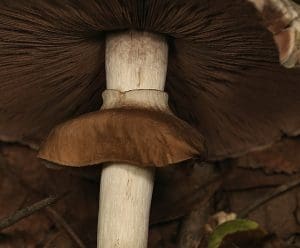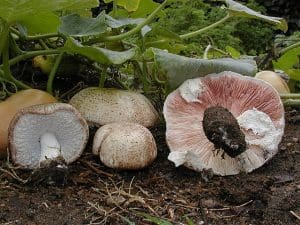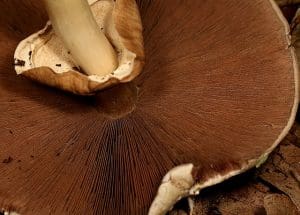Almond Mushroom / Summer / Autumn / Edible
In the world of mushroom foraging, the Almond Mushroom (Agaricus subrufescens) is a fascinating species with its distinctive scent and bountiful growth. Whether you’re an aspiring mycologist or a nature enthusiast, learning to identify this delightful mushroom can be an exciting journey.
From its unique appearance to the unmistakable aroma reminiscent of marzipan, the Almond Mushroom offers a captivating introduction to the diverse world of fungi.
Join me as we delve into the key features and essential tips for recognising this intriguing species in its natural habitat. Let’s embark on a captivating exploration of the enchanting world of the Almond Mushroom.
Scientific Name
Agaricus subrufescens
Common Names
Almond Mushroom, Almond agaricus, Mushroom of the Sun, God’s mushroom, Mushroom of life, Royal Sun agaricus
Family
Agaricaceae
Habitat
They are saprotrophic and can be found in dense leaf litter or in woodchip.
Description
This species is native to North America and was regarded as a choice edible and cultivated. It generally occurs in large groups and as the name suggests they smell of almonds.
Identifying Features of the Almond Mushroom:
Cap:
The cap is hemispherical when young, later becoming more convex, with a diameter of 5-18 cm. The cap surface is covered with silk-like fibers, and as it ages it develops small scales. The colour of the cap is white to grayish with hints of red. They often split at the edge when they are older.

Stem:
The stem is 6-15 cm tall, thick, and bulbous at the base. They often become hollow with age. There is a ring on the stem, that’s quite thick and its covering in cottony scales.

Gills:
The free, narrow, and crowded gills start out whitish in colour, then later pinkish, and finally chocolate brown as the spores mature.


Smell:
Pleasant almondy smell.
Spores:
Brown.
Uses:
In food:
The almond smell doesn’t transfer to taste unfortunately but they are still deliciously sweet and nutty. They’re like a more exciting version of the common shop bought Button mushroom (Agaricus bisporus)and work as a great replacement in any recipe called for them.
The younger specimens have a much nicer texture and are less likely to be infected with bugs.
Known hazards:
No known hazards.
Potential lookalikes:
As with all the Agaricus family the main risks are the toxic Yellow Stainer and the Inky mushroom. The almond smell of the Almond mushroom will rule out both of these chemically smelling species.
An Introduction to Wild Agaricus Mushrooms
Extra Notes from the foragers
The mushroom is used in Traditional Chinese medicine for its supposed anti-cancer properties and recent studies have been performed to confirm the mushroom’s therapeutic properties (Firenzuoli et al., 2008). Identification of novel immunomodulating bioactive compounds from the mushroom may also help in new treatments for patients suffering from cancer and immunodeficiency (Ohno et al., 2001).”
Almond Mushrooms are known for yielding mushrooms in abundance, especially during the warm months of summer. Their prolific growth makes them an attractive option for both amateur and commercial mushroom cultivators. Unlike some of its cousins, such as the white button mushroom and Portabella, the Almond Mushroom is much easier to grow and does not require pasteurisation, caves, or grow houses. This makes it accessible to gardeners and mushroom enthusiasts of varying skill levels. When grown alongside certain plants, the Almond Mushroom benefits from the CO2/O2 gas exchange and the humidity harnessed by the companion plants, creating a mutually beneficial environment for both the fungus and the plants.
References:
https://smallfarms.cornell.edu/2019/07/the-abcs-of-almond-agaricus-mushrooms/






